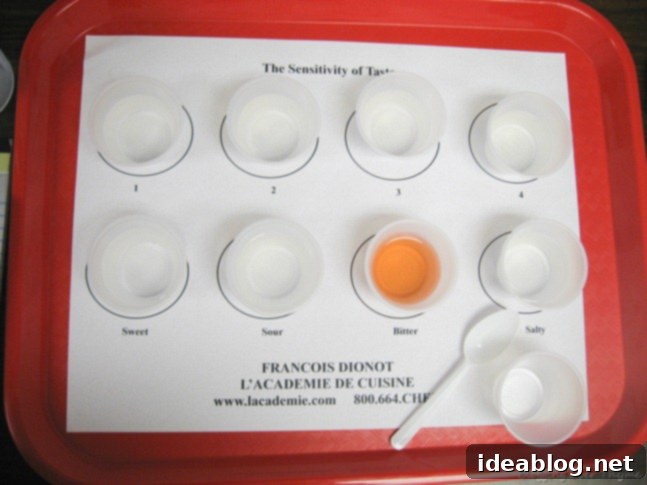Mastering Culinary Arts: A Day of Exquisite Dishes and Sensory Exploration in Phase II
Stepping into the professional kitchen each morning for Phase II of our culinary training is always an exhilarating, albeit exhausting, experience. Today was no exception; it was a whirlwind of activity, packed with advanced techniques and the creation of some truly magnificent dishes. The intensity of professional culinary school means every moment is a learning opportunity, pushing us to refine our skills and deepen our understanding of gastronomy. From intricate main courses to delicate desserts, each plate presented a fresh challenge and a chance to apply the rigorous lessons learned. I can confidently say that today’s menu featured some of the finest dishes we’ve crafted in this phase, each one a testament to the journey we’re on. While I’ll strive to provide ample detail, the sheer pace of the day often means keeping a tight lid on minute-by-minute accounts. However, if any aspect piques your curiosity, please don’t hesitate to leave a comment below!
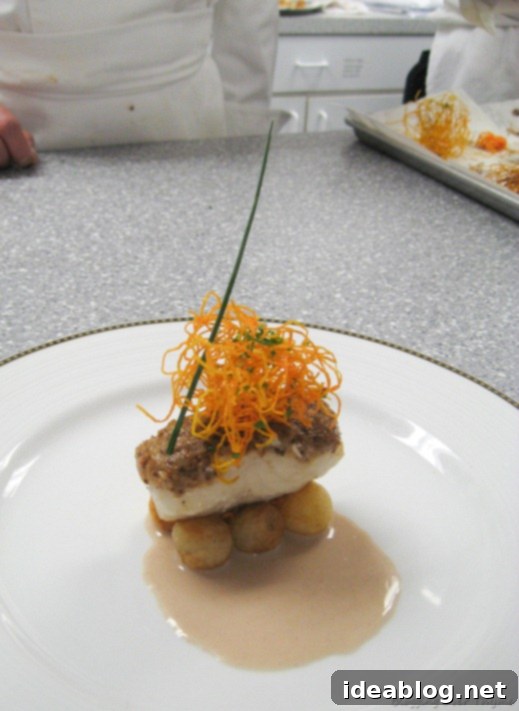
The Main Event: Pan-Seared Halibut with Olive Beurre Blanc
Our star main course for today’s service was a truly exceptional pan-seared halibut, elegantly crusted and served alongside a vibrant olive beurre blanc sauce. Halibut, a highly prized white fish, is celebrated for its firm, flaky texture and mild, sweet flavor, making it a perfect canvas for innovative culinary applications. The goal was to highlight its natural qualities while introducing layers of complementary flavors and textures.
Crafting the Olive Beurre Blanc
Traditionally, a classic beurre blanc is a luxurious, emulsified butter sauce originating from the Loire Valley. It’s meticulously prepared by reducing shallots, peppercorns, bay leaf, thyme, and red wine vinegar, then whisking in cold butter gradually to create a rich, creamy emulsion. The delicate balance of acid and fat defines its character. Our variation today ventured beyond the classic, incorporating finely chopped green olives and a touch of anchovy. I must admit, I wasn’t a great admirer of the traditional version we prepared in Phase I, finding its richness sometimes overwhelming. However, this innovative take, with the briny olives and umami kick from the anchovy, offered a delightful complexity that cut through the butter’s richness beautifully. It was a revelation, perfectly complementing the delicate flavor of the fish.
The Art of the Halibut Crust
The halibut itself was elevated by a carefully prepared crust. This flavorful paste was a symphony of textures and tastes, made from sun-dried tomatoes, toasted walnuts, a hint of robust mustard, and finely cooked onions. Each ingredient played a crucial role: the sun-dried tomatoes provided a concentrated sweetness and tang, the walnuts offered a satisfying crunch and earthy depth, while the mustard added a subtle piquancy. This crust wasn’t just for flavor; it created a beautiful golden-brown exterior when seared, locking in the halibut’s moisture and adding a textural contrast that made each bite exciting.
Innovative Garnishes and Sides
Topping our crusted halibut were delicate strands of specially fried carrots. We achieved their long, thin, almost ethereal shape using a specialized machine—a mandoline or spiralizer, meticulously set to create uniform ribbons. These carrots were then lightly fried to a crisp, providing a unique visual appeal and a delightful crunch. Beneath this culinary masterpiece, we placed perfectly sautéed potatoes. These weren’t just any potatoes; they were meticulously shaped from raw Russet potatoes using what we affectionately call a “melon-baller”—though Chef Patrice was quick to correct us, stating that such devices should technically not be referred to as such when used for potatoes! The consistency and uniform size achieved by this shaping method ensured even cooking and presented an appealing, professional aesthetic. Clearly, a significant amount of technique, precision, and attention to detail went into every component of this seemingly simple dish. Despite the complexity, the process of plating was immensely enjoyable, even if our student efforts didn’t quite match the breathtaking perfection of Chef Patrice’s demonstration (as seen above). The rush of service meant no time for photographs of our own plates, a common lament in the heat of a busy kitchen!
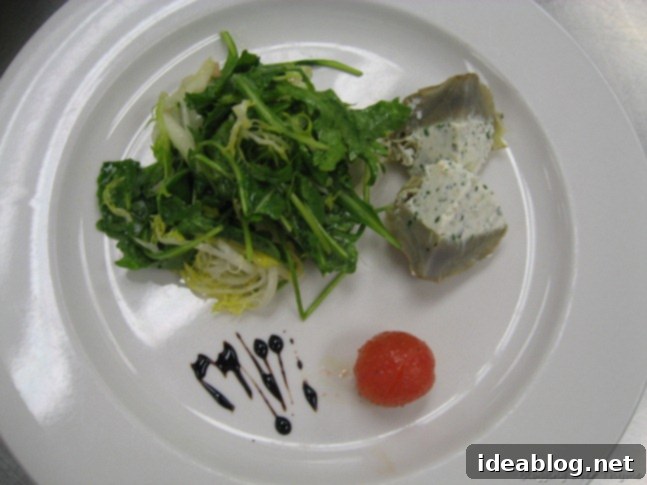
Appetizer Excellence: Goat Cheese Stuffed Artichokes
Our appetizer showcased the elegant simplicity of fresh ingredients transformed by skilled technique: artichokes stuffed with a savory goat cheese mixture. This dish began with the arduous but rewarding task of trimming down whole artichokes to their tender hearts. This intricate process involves carefully removing the tough outer leaves and thorny choke, revealing the edible core. These hearts were then cooked à blanc—a traditional method involving simmering in water with flour, salt, and an acidic component like lemon juice, which helps preserve their color and tenderness. After cooking, each artichoke heart was meticulously reshaped, a testament to the artistry involved even in preparation. The stuffing itself was a delightful blend of creamy goat cheese, fragrant fresh tarragon, basil, and chives, all brightened with a hint of microplaned garlic and seasoned perfectly with salt and pepper. The fresh herbs provided an aromatic lift, while the garlic added a subtle depth without overpowering the delicate cheese and artichoke flavors.
For service, we quartered the stuffed artichoke hearts, arranging them artfully on the plate. They were accompanied by a refreshing frisée and arugula salad, offering a peppery contrast, alongside a perfectly blanched cherry tomato that burst with sweet acidity. A drizzle of rich, dark balsamic reduction completed the presentation, adding a touch of sophisticated sweetness and visual appeal. The combination of textures—the tender artichoke, creamy goat cheese, crisp greens, and juicy tomato—along with the balanced flavors made this appetizer an absolute delight, truly deserving of a “Yum!” It was a fantastic example of how carefully selected ingredients and precise techniques can elevate a simple vegetable into a gourmet experience.
Sweet Finale: Elegant Flambéed Bananas
To conclude our rigorous production, we crafted a deceptively simple yet exquisitely flavorful dessert: flambéed bananas. This dish focused on transforming humble bananas into a luxurious treat through precise caramelization and the dramatic flair of flambéing. The process began by carefully slicing ripe bananas in half, then lengthwise, creating elongated, elegant pieces. These banana pieces were then lightly coated with a delicate dusting of granulated sugar, preparing them for the crucial caramelization step.
In a hot sauté pan, the sugar-coated bananas were caramelized in a small amount of butter. This step is critical; it’s not just about browning, but about achieving that perfect balance where the natural sugars of the banana intensify and meld with the added granulated sugar, creating a complex, golden-brown crust without becoming overly sweet. The Maillard reaction here produces deep, rich flavors that are essential to the dessert’s character. Once perfectly caramelized, the pan was deglazed with a generous splash of rum, and then, for a truly spectacular moment, the alcohol was ignited, creating a dramatic flambé. The flame quickly subsides, leaving behind the complex, toasted notes of the rum infused into the bananas, without the harshness of raw alcohol.
After carefully removing the flambéed bananas from the pan, the remaining pan juices were deglazed further with a small amount of fresh lemon juice, a touch of simple syrup to balance the acidity, and a final knob of butter for richness and sheen. This creates a delicate, flavorful sauce that perfectly coats the bananas. The dessert was then topped with a generous sprinkle of toasted almonds, adding a delightful crunch and nutty aroma that beautifully complemented the soft, sweet bananas. The key to this dessert’s success lies entirely in achieving the right degree of caramelization—just enough to develop deep flavor without pushing it into cloying sweetness. It’s a delicate dance of sugar, heat, and timing that results in a truly delicious and satisfying conclusion to any meal.
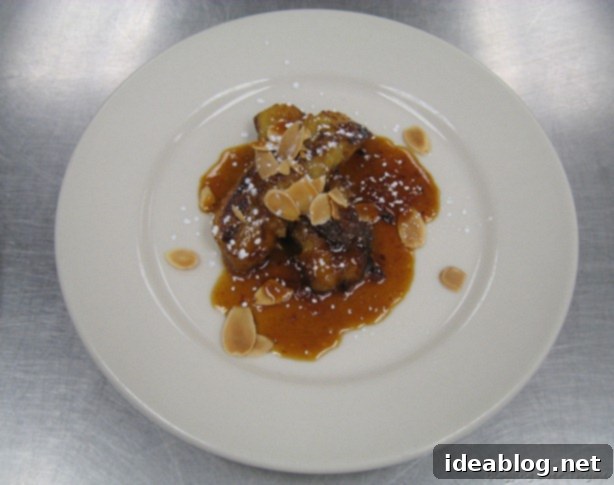
The Rhythms of Service and the Science of Taste
Today’s service session, while generally running smoothly, continued to highlight the significant adjustments required for “serving in succession.” The transition from individual dish preparation to coordinating multiple plates for simultaneous delivery is a monumental shift in culinary school. It demands impeccable timing, clear communication, and seamless teamwork, all under the intense pressure of a live service. Each day, we’re slowly but surely mastering this challenging rhythm, learning to anticipate, adapt, and execute with professional precision.
Immediately following the demanding service, there was no time to linger. We launched into a super-quick clean-up—a non-negotiable aspect of any professional kitchen—before heading back to the classroom. This swift transition was for a fascinating and crucial lecture on the Sensation of Taste, delivered by Chef Francois, the esteemed director of our culinary school. This was not just a theoretical discussion but an interactive exploration into how our palates perceive and interpret flavors.
Exploring the Four Basic Tastes
The entire class engaged in an immersive session dedicated to recognizing and understanding the four basic tastes: salty, bitter, sweet, and acidic (with many now also acknowledging umami as a fifth). Chef Francois guided us through how these foundational elements interact and, more importantly, how our perception of them can shift dramatically depending on the progression of a menu or the sequence in which we taste different foods. This concept is vital for any aspiring chef, as it directly influences dish composition and menu planning.
We were all provided with trays containing small samples of water, each infused with varying concentrations of these fundamental flavors. There were solutions representing pure sweetness, distinct bitterness, sharp acidity, and measured levels of saltiness. Additionally, some samples had incrementally varying amounts of salt, allowing us to perceive subtle differences. The exercise involved tasting them one by one, often revisiting previous samples, to consciously observe and analyze how our taste buds reacted and adapted with each new sensation. It was a truly eye-opening experience, demonstrating the dynamic nature of our palates. This lecture underscored the importance of not just cooking for flavor, but understanding the science behind how those flavors are perceived. It’s a concept I will undoubtedly carry forward and consciously integrate into my thought process when developing and plating dishes in the future, aiming for harmonious and impactful taste progressions.
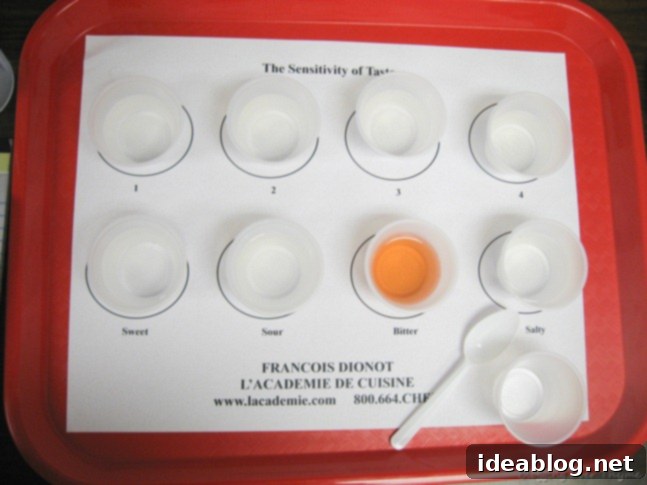
Reflections on Phase II and Anticipating New Beginnings
Tomorrow marks the conclusion of our first demanding week in Phase II. It feels like both an eternity and a blink since we started, a testament to the sheer volume of learning and practical application packed into each day. I’ve already acquired a wealth of new skills and insights, navigating the complexities of advanced culinary techniques and the intense pressures of a professional kitchen environment. However, I must confess, the upcoming weekend is more than just welcome; it’s a much-needed respite to recharge and consolidate all this new knowledge before we dive back into the next week’s challenges.
Beyond the personal learning journey, I’m also keenly looking forward to next week’s arrival of the new Phase I class. It will be fascinating, and perhaps a little bizarre, to see fresh faces embark on the same journey we started not so long ago, albeit from a different vantage point. The culinary school community is constantly evolving, and welcoming new students adds another layer to our shared experience.
The early mornings continue, as I’ll be assisting Chef Michel tomorrow with the intricate preparation of tartlettes for the upcoming dessert demonstration. Every opportunity to work alongside our experienced chefs is invaluable, offering insights into their techniques and organizational prowess. Wish me luck for another productive and inspiring day in the kitchen!
